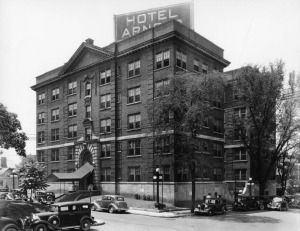November 20, 2014 Students’ “Lost Knox” Project Visually Maps Urban Shift Over 100 Years

Two UT architecture graduate students have visually mapped the site of the old Hotel Arnold and other old downtown buildings that have come and gone as a way to give residents and visitors a glimpse into downtown Knoxville’s past and chronicle the urban density shift. Through their “Lost Knox” project, Whitney Manahan and Jared Wilkins also hope to raise awareness about the importance of conservation and historic preservation.
This past summer and fall, they’ve shared their work with the Historic Zoning Commission and Knox Heritage, during Knoxville’s Pecha Kucha, and at several area schools.
November 20 at 6:00 p.m., the duo will present their work at the Bijou Theatre during Knox Heritage’s Preservation Awards Celebration and Annual Meeting.
“Historic preservation should no longer be in question—it should be a given,” Wilkins said. “As a city we have the potential to grow within our boundaries instead of continuing on the path of sprawl. We simply need to fill in the gaps and increase our urban density. While not aiming to imitate the past, it is important to provide Knoxville with something which adds a new chapter to our city’s exciting history.”
Manahan and Wilkins began the project in the spring in a UT seminar class with visiting professor Larry Scarpa, a well-known Los Angeles-based architect. Scarpa proposed students develop an interactive project that would provide a service to the community. They chose to educate the public about Knoxville’s history and help with the area’s preservation efforts using previous research Manahan had completed for her job at Dewhirst Properties and the Calvin M. McClung Collection at the East Tennessee Historical Society.
“I had seen photographs of so many amazing buildings in the collection that no longer existed downtown and in their places were mostly surface parking lots,” Manahan said. “We decided it would benefit the community and help the preservation efforts in Knoxville to create the project surrounding Knoxville’s lost history.”
Manahan and Wilkins produced diagrams that compare the footprint of downtown Knoxville in 1935 and 2014. They also compiled before and after photos of the building sites and created a Tumblr website to showcase them.
They then created a temporary public installation of plexiglass information plates that hung from street signs around downtown. Each sign included an image of a historic building with the tagline, “You are here.” With the help of classmates, they hung the signs strategically next to the parking lots that originally housed the historic buildings.
Manahan and Wilkins’ project generated interest in the community and since then, civic groups, community leaders, and other individuals have reached out to them for more information about their work.
“We realized how valuable Lost Knox could be as a research tool for the City of Knoxville and as a potential research model for other cities,” Manahan said.
To learn more about the Lost Knox Project and to view photos, visit the website.
—-
PHOTO CREDITS:
Hotel Arnold before: Photo courtesy of Calvin M. McClung Collection at the East Tennessee Historical Society
Hotel Arnold after: Photo courtesy of Lost Knox Project


